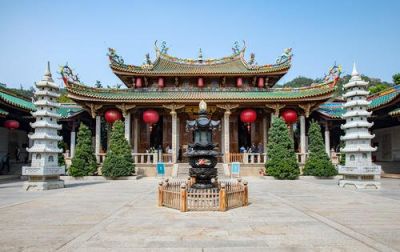
Situated at the foot of Wulaofeng
(Mountain of Five Old Men) and facing the sea, South Putuo Temple is
deemed to be one of the must-go tourist places in Xiamen, Fujian
Province. Even if you are not interested in Buddhism, you will find the
place a scenic area providing you with a refreshing experience.
This
Buddhist temple was once called Puzhao Temple (Universal Grace Temple).
It was first built during the Tang Dynasty (618-907) and was later
destroyed in the warfare during the Ming Dynasty (1368-1644). During the
reign of Qing Emperor Kangxi (1662-1722), a naval general ordered it to
be rebuilt into a Buddhist Temple and named it Nanputuo Temple.
South
Putuo Temple covers 30,000 square meters (36,000 square yards) with
four main buildings on the north-south axis. The buildings include
Devajara Hall (the Hall of Heavenly Kings), Mahavira Hall
(Daxiongbaodian), Dabei Hall (the Hall of Great Compassion) and a
Pavilion built in 1936 in which Buddhist scriptures, Buddha images from
Burma, ivory sculptures and other works of art are stored. The many
rooms flanking the main buildings include dormitories, libraries and
study rooms for monks.
Devajara Hall
Also
called the Hall of Heavenly Kings (Tian Wang Dian), Devajara Hall is the
location of the statues of four ferocious Heavenly Kings. In the center
of the hall stands a fat Buddha, Maitreya or Milefo. With a broad
smile, bare chest and exposed paunch, Maitreya represents the Buddha of
the future, also known as the Laughing Buddha.
Mahavira Hall
Mahavira
Hall in South Putuo Temple is built in 1921 and features the statues of
the Trinity of the Three Ages (Sakyamuni, the Buddha of the Present;
Kasyapa, the Buddha of the Past; and Maitreya, the Buddha of the
Future), Avalokitesvara (Guanyin Bodhisattva, the Goddess of Mercy) and
Avalokitesvara's disciples. most of the attractive murals on the wall
depict Buddhist stories and figures from India.
Dabei Hall
The
Dabei Hall is an octagonal tower which was rebuilt in 1928. Inside,
four Statues of Avalokitesvara are enshrined on a lotus-flower base. The
Bodhisattva with his arms crossed in front of his chest has 48 hands
stretching out. Each hand features a miniature scared eye. Two banyans
are planted on each side of the hall.
Sutra-Keeping Pavilion
The
Sutra-Keeping Pavilion of South Putuo Temple was built in 1936 and
houses thousands of Buddhist scriptures, Buddha images from Burma, ivory
Sculptures, wood sculptures, bronze bells, incense burner and other
works of art. One particular porcelain Avalokitesvara in the Pavilion is
said to be very precious.
The many rooms flanking the main
buildings include dormitories, libraries and study rooms for monks.
Vegetarian food is also served in South Putuo Temple. The dishes' unique
colors, fresh tastes and poetic names make them popular with the
tourists.